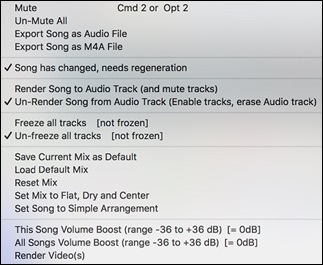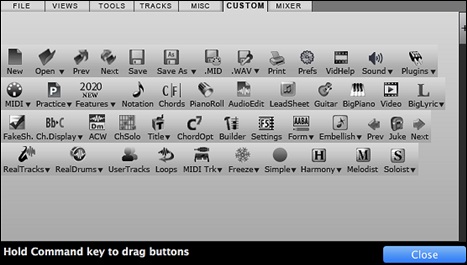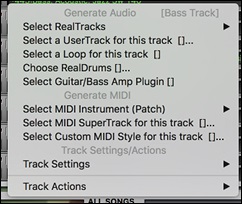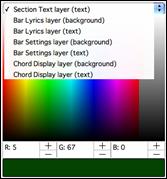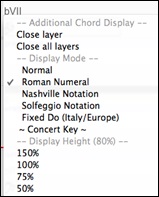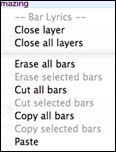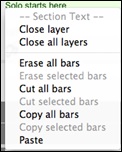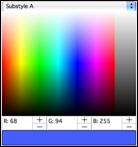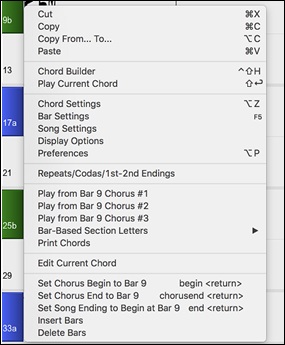Search Manual
Band-in-a-Box® 2020 for Mac® User's Guide
Chapter 4: The Main Screen
Main Screen Overview
The main screen gives direct access to the major features and program settings of Band-in-a-Box for ease and convenience during a session.
There are seven different areas on the main screen.
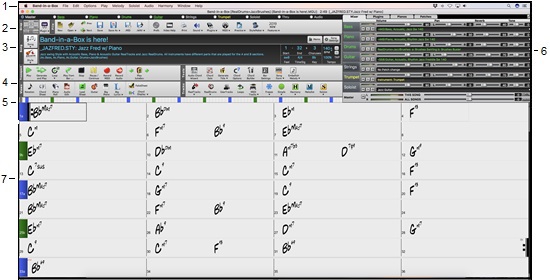
- The Status Bar shows program running status messages and path names of the currently loaded song. This area also includes the Menu Bar. Immediately below it are the Track Radio Buttons, where instruments are assigned and sounds are chosen. Right-click on the instrument names to open a menu of settings for that instrument.
- The Main Tool Bar area has buttons for direct access to important program features and menus. Hold the mouse cursor on any button to see a pop-up hint that describes its function.
- The Song Panel includes the song title and all the other settings for the song such as its Key Signature, Tempo, and Chorus settings. The [Song] and [Style] buttons offer various ways of selecting songs and styles, including the SongPicker and StylePicker dialogs.
- The Function Tool Bars are organized into groups of buttons for related features such as Transport, Tools, Views, and Tracks.
- The Progress Bar displays a timeline for the current song.
- The Mixer is always open in the top right corner. It provides live control of parts with Volume, Pan, Reverb, and Tone settings. It also supports the assignment of plug-ins and patches to individual parts and has a piano keyboard display.
- The Chord Sheet Area occupies the lower part of the screen. Chord changes for the song are typed into the numbered bars (cells) in the sheet. Part markers (a, b, c, etc.) are entered here to switch between up to 24 Band-in-a-Box substyles.Repeats and endings are also shown.
To resize the window, just use the sizing control at the bottom-right corner of the window. Hold down the mouse button while you drag the sizing control. |
|
This allows you to have Band-in-a-Box open as a small window on screen with other programs, and you still see a full Chord Sheet. The screen size is remembered between sessions.
Yellow Alert messages and green Action dialogs
You will see that many Band-in-a-Box messages appear as “yellow alerts” at the top right of screen. That way you don’t have to respond to the message, interrupting workflow. But, if the message box is green instead of yellow, the message is an “action” dialog and you can click on it to perform the action described, such as loading a substitute style. The green action messages have a close button, which is useful for closing them without performing the action.


Personalizing the Main Screen
Band-in-a-Box gives you many options to personalize the main screen.
Screen Layout
The Chord Sheet area (or Notation window) can be displayed in full screen if desired by selecting the “Full Screen Chord Sheet View” from the Window menu or by pressing control+T. (This is reversed by selecting the same option.)
Display Options
Right click on the Chord Sheet and select Display Options from the menu. This opens the Display Options dialog which allows a full customization of the Chord Sheet display including the color for each element, the number of rows or columns, the font and its size, space between sections, and so on. This dialog is also accessible with the [Display] button in the Preferences dialog (Options | Preferences or [Prefs] toolbar button).
Whenever a new section occurs (a part marker), you have the option to start the new section on a new line and draw a grey line above to clearly mark the new section. A section can be just 2 bars long. With this Section Paragraphs feature, you will see each section on a new line so that the form of the song is easy to see.
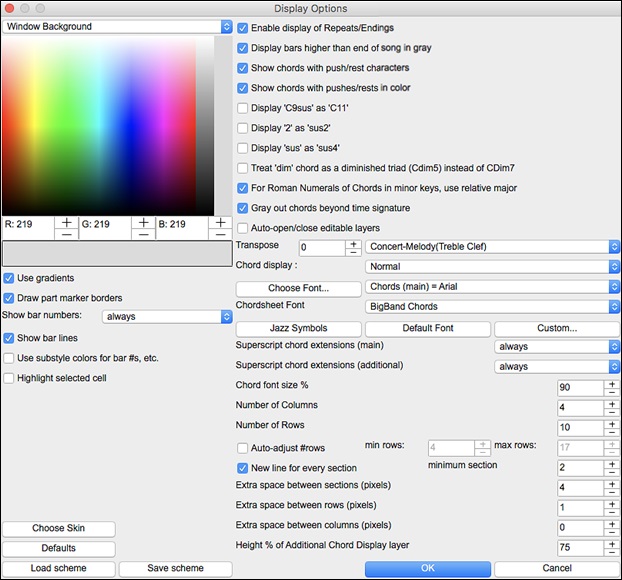
Status Bar
The first thing to note is that the name of the song that is open is identified in the window title at the top of the screen along with the name of the style. This feature is handy when you want to know the status (and the title) of your song and the style in use at a glance. You’ll also see the length of the song in minutes and seconds, and this updates if you change the tempo and press the [Play] button.
![]()
The file name in the status bar will have an asterisk * added if the file has been changed.
Track Radio Buttons
![]()
This bar shows all of the available instrument parts in Band-in-a-Box, including:
- The Melody track, where you can record your own MIDI melody. Or just use it as a sequencer track to record any MIDI track.
- The Soloist track, for solos generated by the Band-in-a-Box Soloist. This track can also be used as a MIDI sequencer track if not needed for a solo.
- The Thru track for play-along on an outboard MIDI device or with the Band-in-a-Box Wizard feature.
- The Audio track for your recorded vocal or instrumental part, or an imported audio file.
The color of the instrument name indicates its type or state.
- White indicates that the part is empty and not in use.
- Yellow indicates a MIDI track.
- Blue indicates a MIDI SuperTrack.
- Green indicates a RealTrack. If the track name is underlined, it also has RealChart notation. If [V] is shown, the track has a video RealTracks.
- Orange is an Audio Performance Track.
- Red means that the track has been muted. When one of the tracks is being soloed, all other tracks will change color to red.
- For the Audio track, orange shows that an audio recording is present on the track.
If you have customized the track settings of a song (e.g. by overriding the settings in a style and putting a different RealTracks), it will be indicated by an equal sign in the track name by an (e.g. =Piano).
Automatic track naming with numbers. With previous versions, the tracks were always called the same names - Bass, Piano, Drums, Guitar, and Strings. Now, the track labels show the instrument names. And if there are multiple tracks with the same instrument, a number (1, 2, etc.) will follow. For example, if you load in the Slow Bluegrass Waltz style, you will see track buttons like these:

If you want the track names “the old way” (Bass/Piano/Drums/Guitar/Strings/Melody/Soloist or B/P/D/G/S/M/S), then uncheck the “Auto-Generate Track Labels” option.
RealDrums can be added to any track, not just the Drums track, so you can have more than one drums track. To do this, right click on the track button and select Choose RealDrums from the menu. When there are multiple drums tracks, they will be automatically called Drums 1, Drums 2 etc.
![]()
Master Button
|
When the Master button is selected, changes to volume, reverb, etc. will apply to all parts. Right click on the button to open a menu of commands. |
|
Mute and Un-Mute All will mute or unmute all parts. Export Song as Audio File will render the tracks together into one AIFF file. Export Song as M4A File will render the tracks together into one m4a file. Song has changed, needs regeneration will regenerate a new arrangement for all parts. Render Song to Audio Track (and mute tracks) will consolidate all tracks into audio data and move it to the Audio track. Un-Render Song from Audio Track (Enable tracks, erase audio track) will erase the Audio track and allow tracks to be generated by the current style again. |
The Freeze and Un-freeze commands apply to all tracks.
If you like the current mix (of volumes, panning, reverb), and you want this applied as a default for all songs, you can choose Save Current Mix as Default. Load Default Mix restores the default mix you have saved, and Reset Mix sets the mix back to “factory defaults.”
Set Mix to Flat, Dry and Center sets the song to Flat (all volumes=90), Dry (no Reverb) and Center panning. This is useful when rendering individual tracks and transferring to a DAW.
The Set Song to Simple Arrangement checkbox makes the RealTracks play a simpler (less busy or embellished) arrangement.
This Song Volume Boost (range -36 to +36dB) opens a dialog where a dB value can be entered that will affect only the current song. For reference, 6dB is generally considered to double the volume; -6dB would be half the volume.
All Songs Volume Boost (range -36 to +36dB) opens a dialog where a dB value can be entered to adjust the overall volume of all songs. A setting of 6dB is twice as loud; -6dB is half as loud.
Render Video(s) allows you to make a video of RealTracks that are selected for your song, optionally with the chord sheet or the corresponding notation.
Individual Track Buttons
A right-click on any track button opens a menu of commands and settings that can be applied specifically to the individual track. The menu is organized into groups allowing easier selection of track types: audio (RealTracks, UserTracks, Loops) or MIDI (MIDI SuperTracks, classic MIDI tracks) and track settings/actions.
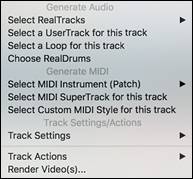
Select RealTracks
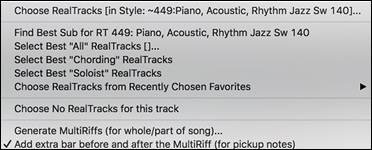
Choose RealTracks generates the part as a RealTrack using any available RealTracks instrument.
Choose Select Best “Soloist” RealTracks to add a best Soloist to any track.
Select Best “All” RealTracks will show all RealTracks, sorted by best to worst for the current style, and Select Best “Chording” RealTracks shows the list for comping (i.e. Chording, non-Soloist) RealTracks.
Find Best Sub will allow you to find a replacement that is similar to the currently selected RealTracks
Choose RealTracks from Recently Chosen Favorites opens a list of recent RealTracks used.
Choose No RealTracks for this track will remove the current selection from the track.
Generate MultiRiffs will generate 7 variations of riffs from the same RealTracks for either a portion of the song or the whole song. Once the tracks are generated, the 7 files are saved as WAV files and can be accessed from the Drop Station.
Add extra bar before and after the MultiRiff adds an extra bar before the riff begins to ensure that the riffs with “pickup” (early) notes will be heard. It does not add an extra bar at the end of the riff unless there are trailing notes.
Select a UserTracks for this track lets you assign a track from the list in your UserTracks folder. UserTracks work like RealTracks but are created from the user’s own audio recordings.
You can play an audio loop (your own or 3rd party) on any track with the Select a Loop for this track command.
Choose RealDrums allows you to add RealDrums to any track, not just the Drums Track.
Select Guitar/Bass Amp Plugin will list all available TGS files for guitar/bass amp plugins. (Note: This menu item will be shown on an audio track.)
Select MIDI Instrument (Patch) is used to assign an instrument to a MIDI track from the Hi-Q patch list, the General MIDI patch list, the General MIDI 2 patch list, the higher bank patches on your particular synthesizer, or from a preselected list of favorite patches.
 |
Use the Select Hi-Q MIDI Patch Plugin command to select a preset of a Hi-Q instrument and a VST/AU plugin (e.g. sforzando). (Note: This menu item will be shown on a MIDI track only.) |
Select MIDI SuperTrack for this track opens a list of available MIDI SuperTracks. They can be used in the same way as RealTracks.
Select Custom MIDI Style for this track lets you play your favorite MIDI track from any style on any track of your current style, including the Melody and Soloist tracks. The track you assign doesn’t have to be the same instrument, i.e., you could assign a Guitar to the Strings track.
Track Settings
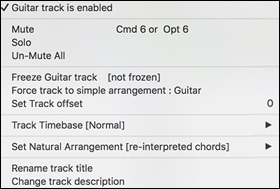 |
Guitar (*or any part) track is enabled. This command is the easy way to disable/enable a track, even during song playback. To disable a track, right-click on the track name (at top of the screen or on the mixer) and select enable/disable the track. When a track is disabled, the color is dark gray on the main screen and on the mixer. You can Mute or Solo the individual part. Solo mutes all but the soloed part. Un-Mute All is useful to restore all other parts after a part has been soloed. |
Freeze the track if you do not want the part regenerated on each play. Tracks can be unfrozen.
Force Track to simple arrangement makes the RealTracks play a simpler (less busy or embellished) arrangement.
Set Track offset allows the track to moved ahead or behind by +/- 1000 ticks (at a resolution of 120 PPQ).
Track Timebase allows you to select a timebase (normal/half/double/triple).
Set Natural Arrangement allows re-interpretation of chords for the selected track of the current song.
Rename track title allows you to change the track label for the selected track.
Change track description allows you to change the track description.
Track Actions

Select (re)Generate RealTrack to (re)generate the RealTrack.
Erase Track removes either the MIDI or RealTracks data from the track.
Select Track as AIFF File or Select track as M4A File will save a track (RealTracks or MIDI) as AIFF or M4A audio file to a folder you choose.
Save Track as Performance File (AIFF/M4A) renders the track to your choice of an AIFF file or a M4A file.
Render Video(s) allows you to make a video of RealTracks that are selected for your song, optionally with the chord sheet or the corresponding notation.
Audio Track Button
Right click on the Audio label to quickly mute, solo, or delete the Audio track.

Toolbars
The toolbar buttons give quick access to program features. They are grouped according to function.

Toolbar Modes
There are three modes for the toolbar.
1. ![]() Smaller, configurable toolbar with tabbed interface.
Smaller, configurable toolbar with tabbed interface.
![]()
In this mode, the [CUSTOM] tab lets you select and add buttons in the order that you want.
|
First, click on the [+] button on the right to open a palette of buttons. |
|
Then, while holding down the Command key, drag buttons around to add, remove, or set the order. |
2. ![]() Taller toolbar, with fixed on-screen Mixer. This is useful for people with hi-res screens.
Taller toolbar, with fixed on-screen Mixer. This is useful for people with hi-res screens.
3. ![]() DAW mode. This makes a small screen, always on top. This is useful when you drag and drop tracks to your favorite DAW.
DAW mode. This makes a small screen, always on top. This is useful when you drag and drop tracks to your favorite DAW.
Drop
|
The Drop Station is used to drag and drop tracks from Band-in-a-Box to Digital Audio Workstations (DAWs) that don’t support direct drag and drop. Many DAWs will allow you to do this directly, but if your sequencer does not support the direct drop of a track that is not yet generated, then you can drag from a radio button (Master, Bass, Piano, etc.) to the Drop panel. |
The four Drop quadrants show different file types. Your file will be rendered to the file type of the quadrant you drop it in and the button will change color to orange, indicating that the file is accepted and being prepared.
![]() When you drop the track to the [+] button, you are presented with a dialog, where you can choose a file format and other render options.
When you drop the track to the [+] button, you are presented with a dialog, where you can choose a file format and other render options.
|
When the button turns bright green, the track has been generated and is ready to drag from the Drop zone to your DAW. |
The Drop Station has a right-click menu, allowing you to copy the resulting file to a favorite folder, open the favorite folder, audition or email the dropped file, start/stop the DAW Plug-in mode, upload to Dropbox, and more.

|
The DAW Plugin button has two menu items. One starts or ends the plug-in mode, which lets you drag and drop MIDI or audio files from Band-in-a-Box to your DAW or Finder. The other opens a Plugin Settings dialog, which allows you to control drag ‘n’ drop operations. (See Chapter 12 for more details about the drag ‘n’ drop feature.) |
File
This section is for the file functions like Open, Save, etc.
|
The [New] button clears the Chord Sheet to start a new song. Band-in-a-Box reminds you to save your work before it erases the chords. |
|
The [Open] button shows a menu to open (load) songs into the program using various methods. |
|
This opens the previous song in the folder in alphabetical order. |
|
This opens the next song in the folder in alphabetical order. |
|
The [Save] button is used to save the current song to disk. |
|
This shows a menu to save a song using various methods. |
|
The [.MID] button allows you to save a song as a Standard MIDI File. |
|
Clicking this button shows a menu with selection for quick rendering the song to an audio file (aiff/wav/m4a/mp4) and opening Render to Audio File dialog, which allows you to choose options. |
|
Use the [Print] button to launch the Print Options dialog, which allows you to print Lead Sheet or Fake Sheet style notation. |
|
The [Prefs] button will bring up the Preferences dialog where you can set various settings and access program options. |
|
The [Sound] button shows you a menu to choose sound options such as MIDI port selection or help with AirPlay. |
|
The [Plugins] button shows you a menu with options to open Plugins dialog, set the default synth, or open Reverb Settings dialog for configuring audio reverb settings. |
|
The [MIDI] button shows you a menu with various options for MIDI use and allows you to enable the MIDI keyboard Wizard (playalong on lower 2 rows of QWERTY during playback). |
|
The [Practice] button shows you a menu for practicing with Band-in-a-Box. |
|
This button launches the StyleMaker, which allows you to edit or make styles (.STY files). |
|
Click this button for a link to video demonstrations and tutorials. |
|
This button shows you a menu to open the new features tutorial pages from PG Music website. |
Song
This section is for information related to the current song, including the current style, tempo, key, form, etc.

|
The Song button lets you load a song. This is a split button. The top half of the button uses the default method to load a song. The bottom half shows a menu of different methods to load a song and allows you to set the default action for the top. |
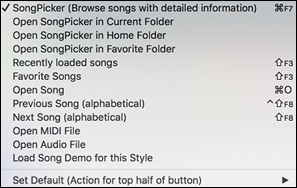
|
The Style button is also a split button, with the top half being the default function, and the bottom half-listing different methods to load a style and allows you to set the default. |
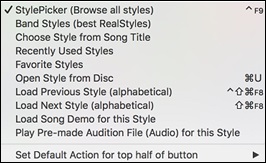
The song title is displayed, and you can type in the name in this box.
![]()
Directly below the song title, the style display shows the style name and more information about the style.

- Style file name (Short)

- Style Name (Long)

- Style Memo

- List of instruments (and indication if they are MIDI or Real)

|
You can type any information about your song in the Memo window. |
|
This button opens a full menu of settings to use for a polished song arrangement, including a tag (coda), automatic endings, style variations and more. |
|
Chorus Begin button: Click on the Chorus Begin button and then click on a bar number or type a number in the dialog to select the first bar of the chorus. The Bar number that you select is displayed. |
|
Chorus End button: Click on this button and then click on a bar number or type in the dialog to select the last bar of the chorus. The Bar number that you select is displayed. |
|
The number of choruses possible for a tune is 40. Click on the chorus button and choose how many choruses you require. |
|
This is the feel (swing or even, and 8th of 16th) of the song. The feel is determined by the selected style. |
|
This is the time signature of the song. You can click on it to change the time signature. |
|
The key box is used to set the key or to change it and transpose the song. When you press it, you see 2 columns of keys. The first column will set the key AND transpose the song; the second will just set the key signature. |
|
The Tempo Control shows the current song tempo. Left-click on the up/down arrows to change the tempo by +/- 5 beats per minute. Right-click to change it by +/- 1 bpm. Tempos can also be typed in directly. |
|
This button allows you to quickly set the relative tempo. Click the button and choose a percentage or use the Custom Tempo % menu item to set any value between 1% and 800%. 1% would be 1/100 of the original tempo and 800% would be 8 times the original tempo. Hotkeys are available: control - (minus key) for half speed and control = for normal speed. |
|
Use the tap tempo buttons to count and set a tempo. Tap the [-] button in tempo four times to set the tempo. It will appear in the tempo box. Tap the [=] button to count-in the song and start playback at the tapped tempo. As you tap more than 4 times, the accuracy will improve (through averaging) and you can continue to tap until the target tempo has been reached. For example, in a 4/4/ style, once you tap 4 times a tempo will be set. But you can keep tapping and the tempo will change every beat, based on the average tempo that you have typed. |
Transport
These buttons are like the transport controls on a media player.
|
The [Play] button plays the song from the beginning without creating a new arrangement, unless regenerating is required. |
|
The [Generate and Play] button generates a new Band-in-a-Box arrangement and then plays the song. |
|
The [Loop] button plays the selected (highlighted) section of the Chord Sheet in a loop. The dropdown menu has settings for looping the entire song. |
|
The [Play from Bar] button is used to play a song starting anywhere in the song, including tags or endings. This feature is also available from the right-click menu in the Chord Sheet. |
|
The [Stop] button stops the song or the Jukebox from playing. |
|
The [Pause/Continue] button pauses the song during playback. Press again to continue from the paused location. |
|
The [Record MIDI] button is to record a song from the beginning. The music that you play in to the computer will then be stored on the Melody track. The control+R keys are the keyboard equivalent. |
|
The [Record Audio] button launches the Record Audio dialog for recording live audio recording. |
|
The [Play Jukebox] button is used to start or stop the Jukebox. The [ï] and [ð] arrow keys are used to move to either the previous or next song in the Jukebox. |
|
Tools
This section is for miscellaneous Band-in-a-Box tools.
|
Press the [Chord Solo] button to launch the Generate Guitar Chord Solo dialog. |
|
This will automatically generate a song title for you. |
|
This button launches the Chord Options dialog box, which allows you to add chord pushes, rests, shots, and held chords for any given bar. |
|
This is the Chord Builder button. Chords may be heard and entered to the Chord Sheet by clicking in this dialog. |
|
F5 Bar Settings - Launches the Edit Settings for Current Bar dialog. This allows you to enter changes to the arrangement at any bar or chorus. The hot key is F5. |
|
Song Form - launches the Song Form Maker dialog and other tools to control the form of your song |
|
The grace note button enables the embellisher and opens the Melody Embellisher dialog for customizing the embellisher. |
Views
This section includes buttons to open Chord Sheet, Notation window, Guitar window, etc.
|
This button toggles between the Notation window, where you can enter chords and lyrics, edit notation, and view MIDI notation, and the Chord Sheet, where you enter chords for your song. |
|
This displays the Chord Sheet window. This is the default window in Band-in-a-Box, where you enter chords. |
|
This launches the Piano Roll window for editing the Melody or Soloist track in a piano roll format, including graphic controller editing. (Tip: Shift+clicking on tthe button will open the movable and resizable window.) |
|
This button launches the Audio Edit window, which displays a graphical waveform and allows editing the Audio track. (Tip: Shift+clicking on tthe button will open the movable and resizable window.) |
|
This opens the Audio Chord Wizard, which automatically figures out the chords from an autio file. |
|
The Lead Sheet notation is a multi-line notation display in a lead sheet style. The Lead Sheet can display more than one track at a time. |
|
The [Guitar] button launches the Guitar window that displays guitar notes as music is playing. |
|
The [Big Piano] button launches the Big Piano window, which will display the notes to any track (except drums) as the music is playing. |
|
The [Drums] button launches an animated Drum Kit window. Press it to launch this fully functional (and fun) GM-MIDI “virtual” drum kit. |
|
The [Video] button opens a menu with selections to open the Video window and the Generate Video dialog. |
|
This button opens the Big Lyrics window for full screen “Karaoke-style” scrolling lyrics. |
|
This allows you to view the Chord Sheet in the Fake Sheet mode, which displays repeats, 1st/2nd endings, and codas. Use the menu to set repeats, endings, and codas. |
|
The [Chord Display] button has a menu that allows you to set the font and the color for Chord Sheet, chord type (normal, roman numerals, Nashville notation etc.), transpose options (alto sax etc.), and capo transposes (for guitar). |
Tracks
This section is for adding tracks to Band-in-a-Box (RealTracks, Loops, UserTracks etc.).
|
This button shows you a menu with selections for the RealTracks Picker, RealTracks Settings, and a command to “Select better RealTracks” for the song tempo. |
|
This button shows you a menu with selections for the RealDrums Picker and RealDrums Settings. |
|
UserTracks are like RealTracks but are made by you or third parties. This button opens a window, which lists available UserTracks you can add to any track. |
|
This button is for the Loops Picker, where you can choose an Audio Loop or Acid Loop (aiff/wav/m4a/mp3) to add to a track (e.g., nature sound, drum loop, etc.). You can add your own loops to the Loops folder in the RealTracks folder. |
|
This button shows you a menu of options to choose a MIDI SuperTrack or open the MIDI Track Picker dialog to add a MIDI track from a different style to the current song. |
|
This shows you a menu of options to freeze or unfreeze all tracks or just freeze individual tracks. Frozen tracks play without regenerating for faster playback. |
|
This button allows you to force any track or all tracks to play with simple arrangements. You can set this for the current song or all songs. |
|
Band-in-a-Box can automatically add MIDI harmonies to the Melody track or the Thru/Soloist track, giving you harmonies for your live playing on the Thru channel or QWERTY wizard. |
|
The [Melodist] button opens the Generate Chords and/or Melody dialog, where you can generate a new song with chord changes and melody as well as an improvised solo, and an original song title. |
|
This shows you a menu for either selecting a RealTracks soloist from a list of best soloists, or opening the Select Soloist dialog, where you can choose a custom soloist (MIDI or RealTracks) to play over any given chord changes. |
Progress Bar
![]()
This bar displays a timeline for the current song.
|
The current time is marked with a gray vertical line. You can click on the bar to move the current time to that point. |
|
Part markers are marked with colored (blue, green, etc.) vertical lines. |
|
The beginning of each chorus is marked with outlines. |
|
You can double click on the bar to start playback from that point. |
Mixer
Mixer window shows the current state of instruments and parts and allows easy changes or adjustments. In the tall fixed toolbar mode, the window is always open in the upper right section of the main screen. If you want to see the floating Mixer, which can be resized and “parked” anywhere on the screen, then go to Window | Floating Mixer Window or use the hot key control+M. In the small configurable toolbar mode, the [MIXER] tab will open the floating Mixer.
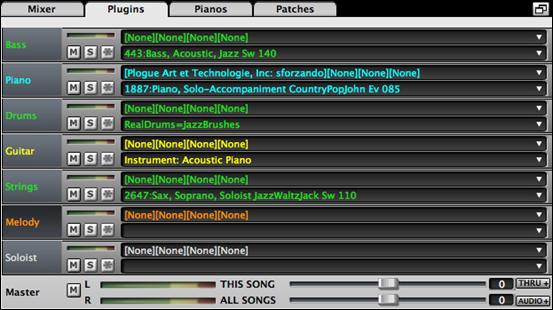
![]() The small button at the top right corner will switch to the floating mode, which allows you to resize or move the window to anywhere on the screen.
The small button at the top right corner will switch to the floating mode, which allows you to resize or move the window to anywhere on the screen.
![]() In the floating mode, you can change the window’s opacity. Left-click on these buttons to change the opacity by a significant amount, or right-click on them to change it by a small amount.
In the floating mode, you can change the window’s opacity. Left-click on these buttons to change the opacity by a significant amount, or right-click on them to change it by a small amount.
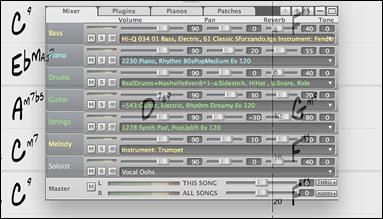
The window has four different screens for Mixer, Plugins, Piano, and Patches. The default screen is Mixer, where you see the currently assigned instruments for the song.
With previous versions of Band-in-a-Box, the tracks were always called the same names - Bass, Piano, Drums, Guitar, and Strings. Now, the names match the styles. And if there are multiple tracks with the same instrument name, a number (1, 2, etc.) will be shown. For example, if you load in the Slow Bluegrass Waltz style, you will see these names: Bass, Guitar 1, Mandolin, Guitar 2, and Banjo.
You can drag track labels from the Mixer and drop them to the _Drop_Station to render audio or MIDI files.
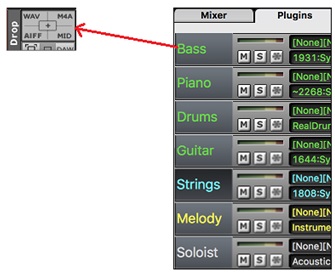
If you click on the track description on the Mixer and go to Track Settings, you will see two new items that you can use to rename the track tile or description..

You could, for example, change the track label from Banjo to “5-String” and add a track description like “Hot Pickin Banjo Riffs.”

![]() In the Mixer screen, each individual track has settings for Volume, Pan, Reverb, and Tone that can be adjusted as the song is playing. Volume, Pan, and Reverb are controlled by horizontal sliders. Tone is controlled by typing in a number from -18 (full bass) to 18 (full treble), or by clicking on a number and dragging the mouse cursor vertically.
In the Mixer screen, each individual track has settings for Volume, Pan, Reverb, and Tone that can be adjusted as the song is playing. Volume, Pan, and Reverb are controlled by horizontal sliders. Tone is controlled by typing in a number from -18 (full bass) to 18 (full treble), or by clicking on a number and dragging the mouse cursor vertically.

Hold the [control] key down as you click on the track slider and drag the thumb of the slider. This will force all tracks to move to the same absolute location as the original track. Hold the [shift] key and it will move all tracks relative to the move of the original track.
Double clicking on the slider sets the value to a default value.
Each track in the Mixer screen shows the name of the instrument assigned to it.
![]() Yellow text indicates a MIDI instrument.
Yellow text indicates a MIDI instrument.
![]() Green text indicates RealTracks or RealDrums.
Green text indicates RealTracks or RealDrums.
|
Right-click or double-click on a part name for a menu of settings and actions for the selected part. The menu is organized into groups allowing easier selection of track types: audio (RealTracks, UserTracks, Loops) or MIDI (MIDI SuperTracks, classic MIDI tracks) and track settings/actions. |
|
Each track has its own VU meter to show the sound level, and buttons to Mute, Solo and Freeze the track. |
There is also a Master section.
![]()
Master Mute: |
|
|
VU Meters: |
|
|
Master Volume (this song) and Master Volume (all songs): |
|
|
The Master Volume is a new type of volume setting for Band-in-a-Box, and is a true Master Volume, in that it applies a decibel (dB) boost to the master signal, independent of the tracks volumes. So, for example, if you want all Band-in-a-Box songs to be louder, you can simply set the “All Songs” Master volume slider (e.g. to +6 dB) and this boost will apply to audio output from all instruments (MIDI and audio) for all songs.
|
The Audio panel will automatically open and close if the song has Audio track. It can also be opened and closed manually with the [AUDIO+] button. |
|
Since most people don’t need to have the Thru track visible on the main screen at all times, there is a THRU button on the mixer that will show/hide the Thru track. |
The [Piano] tab shows on-screen pianos for each track. Clicking on a piano key adds a note to the Notation window (if in the editable mode) at the current time.

The [Patches] tab shows the instrument names at a bigger size.

The [Plugins] tab is for adding audio or MIDI plugins to each track.

Each track has 4 slots. For a MIDI track, the first slot can take a VST/AU synthesizer (e.g. Sforzando, SampleTank, etc.) and the other 3 can take audio effects (e.g. Dynamics, PeakLimit, AmpliTube Amp simulation, etc.).
![]()
For an audio track (RealTracks, Loops, or the Audio track), there is no synthesizer slot, so you can assign up to 4 audio effects.
![]()
When you click on a slot, this launches the Plugins dialog, which allows you to select a VST/AU synthesizer and/or VST/AU audio effects.
![]()
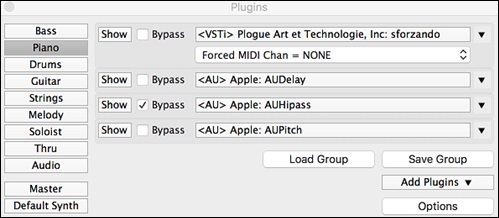
|
Click on a slot to select a VST/AU synthesizer and/or audio effects for the selected track. |
|
Click this button to load or save presets for the selected plugin. |
|
You can hide or show the plugin window assigned to the slot. |
|
When this is checked, the track won’t be processed through the plugin. |
|
|
You can save and load Groups. A Group is the complete setting for all 4 slots. |
||||
|
This button allows you to choose VST plugins individually, scan a folder, or scan the system folder. |
|||
|
This will open the Plugins Options dialog where you can change preferences for plugins. |
|||
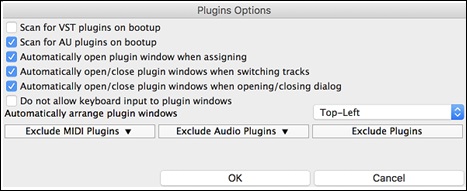
Scan for VST plugins on bootup: Enable this option if you want Band-in-a-Box to scan for new VST plugins every time it boots up. This only includes plugins that have not been found previously.
Scan for AU plugins on bootup: Enable this option if you want Band-in-a-Box to scan for new Audio Unit plugins every time it boots up.
Automatically open plugin window when assigning: If this is checked, a plugin’s window will open automatically when you assign to a track. This only applies if the Plugin dialog is open.
Automatically open/close plugin windows when switching tracks: If this is checked, then when you switch tracks in the Plugins dialog, plugin windows currently open will close and then plugin window on the new track will open.
Automatically open/close plugin windows when opening/closing dialog: If this is checked, then when you open the Plugins dialog, plugin windows for the current track will open, and when you close the Plugins dialog, all plugin windows will close.
Do not allow keyboard input to plugin windows: Enabling this will prevent plugin windows from taking focus away from Band-in-a-Box, so keyboard input always goes directly to the main program. Disable this if you are using plugins that use keyboard input.
Automatically arrange plugin windows: Plugin windows can be arranged automatically according to the assigned track, and the position in the plugin chain. It this option is disabled, then each plugin window will open at its previous position.
[Exclude MIDI Plugins] You can choose MIDI plugins to exclude. Excluded plugins will not show up in the lists and will never be loaded by Band-in-a-Box.
[Exclude Audio Plugins] This allows you to choose audio plugins to exclude. Excluded plugins will not show up in the lists and will never be loaded by Band-in-a-Box.
[Exclude Plugins] You can choose specific VST/AU plugin files that you do not want Band-in-a-Box to attempt to load when scanning for new plugins.
Chord Sheet Area
Chords, rests, shots, holds, and part markers are entered in the Chord Sheet.
The Chord Sheet can be viewed in the full linear view showing all bars, or optionally in fake sheet view that shows 1st and 2nd endings and repeat signs. Another option shows bars past the end of the song in gray.

You can use [Tab] and [Shift]+[Tab] keys to navigate through the Chord Sheet.
Fake Sheet Mode
Open a demo song “Repeats Tutorial example 2 with 1st-2nd and DC al Fine” from the Band-in-a-Box/Tutorials/ Tutorial - Repeats and Endings folder.
|
To view the Chord Sheet in the Fake Sheet mode, click on the [Fake Sheet] button on the toolbar and enable the Display Chord Sheet in Fakesheet Mode menu option. |

|
When you disable the Fake Sheet mode by pressing the [Fake Sheet] button and deselecting the Display Chord Sheet in Fakesheet Mode menu item, the Chord Sheet will display in the full linear mode. |
In this mode, you see all the bars in the order that they will be played.

Chord Entry
The basic way of entering a song in Band-in-a-Box is by typing in the chords to the song using the computer keyboard. Chords are typed in using standard chord symbols (like C or Fm7 or Bb7 or Bb13#9/E).
Chords can be cut, pasted, and copied from one location to another.
Another way of entering chords is through MIDI chord recognition. Play any chord on your MIDI keyboard; and Band-in-a-Box will recognize it instantly and insert it onto the Chord Sheet. This allows you to enter an entire song without having to type in any of the chords!
To use this feature, select the Options | MIDI Patch Maps | Insert current MIDI chord menu command. control+return is the keystroke combination for this function.
The chord you choose will automatically be inserted into your song (Chord Sheet or notation view) at the current cursor location. Then, Band-in-a-Box is ready for the next chord. You can insert up to two chords per bar in this fashion.
For details about chord entry, see the “Entering Chords” section in Chapter 6.
Chord Sheet Options
“Layers”
Layers are optional rows of information shown above each bar.

When there is no additional information within a row, that row will not show to maximize space on the Chord Sheet.

|
You can choose which layer to display by clicking on the [Chord Display] button on the toolbar and selecting Layers. |
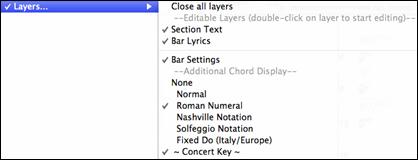
The “Section Text” layer is for editable text (up to 255 characters per bar) that is loaded and saved with the song.
![]()
The “Bar Lyrics” layer is for editable bar-based lyrics (up to 255 characters per bar) that are loaded and saved with the song. (See the “Adding Bar-Based Lyrics” section in another chapter for more details.)
![]()
The “Section Text” and the “Bar Lyrics” layers will attempt to intelligently separate your lyrics into different bars. For example, if you have a whole song of lyrics in a text file and the lyrics for every bar are on separate lines, you can simply highlight the entire block of text and paste it into Band-in-a-Box using command+V keys. Every line of text will occupy a separate bar. If the lyrics have not been distributed into the correct bars, you can move your text cursor to the beginning of a bar and press BACKSPACE to move the lyrics to the previous bar. This will shuffle the text in the following bars one bar backward as well. Hitting RETURN will move all the text after the text cursor to the next bar and shuffle the text in the following bars one bar forward. If you wish to see more than one line within a bar, you can hold down the COMMAND key while using the RETURN key, which forces a line break (second line) within the bar.
There is an option in the Display Options dialog to automatically open or close the Bar Lyrics and Section Text layers when you open a song that contains Bar Lyrics or Section Text.
The “Bar Settings” layer shows information about any changes that occur for that bar, as set in the Bar Settings dialog (e.g. tempo changes, key changes, etc.).
![]()
The “Additional Chord Display” layer shows the chords using the normal display or an alternative mode of showing root notes. There are four alternative modes: Roman Numeral, Nashville Notation, Solfeggio Notation, and Fixed Do (Italy/Europe).
![]()
The height of this layer can be set as a percentage of the main chord using the “Height % of Additional Chord Display layer” setting in the Display Options dialog. For example, you might want to see Nashville Notation as big as the main chord display below it.
The “Concert Key” option allows you to display an additional chord display of the same chords transposed to a different key. So, for example, you can see two layers, one with concert chords and the other for Bb instruments.

All the layers can be customized with font and color in the Display Options dialog.
|
|
Right clicking in a layer has a menu with options to change height of the layer, close layer(s), copy/cut/paste, etc.
|
|
|
Display Options Dialog
You can set up the Chord Sheet with your own preferences.
|
Click on the [Prefs] toolbar button to open the Preferences, and then click on the [Display Options] button to open the Display Options dialog. |
You can also right click on the Chord Sheet and select Display Options from the menu to open this dialog.
![]()
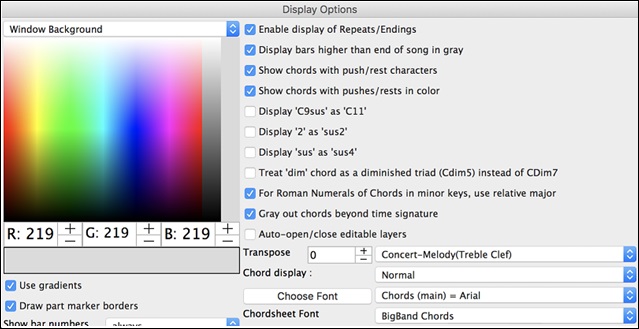
Chord Sheet Color
|
You can choose any color for each element on the Chord Sheet. For example, you can choose color for substyle A & B part markers. Previously, the color of the chords was always black, so you were limited to brighter colors for the background since darker backgrounds would make the chord text hard to see. Now, all the colors can be picked from the color palette, and any changes you make can be seen on the Chord Sheet in real time. |
Superscript Option
Superscript shows the chord extensions with smaller raised font, making the root of the chord more distinguishable and helping maximize space on the Chord Sheet. The Display Options dialog has separate settings for the main chords and additional chords.
![]()
In this example, extensions of the main chords will always show with small raised font, but extensions of the additional chords will not show with superscript.
![]()
Number of Columns
You can set the number of bars to show on a row with the “Number of Columns” option.

Space between Columns
You can set the border thickness between columns with the “Extra space between columns (pixels)” option.
![]()
Chord Sheet Font and Colors
|
Chord Sheet font and color can be also changed easily from the on-screen button, with visual menu. |
Transpose Chord Sheet option
|
This button also allows you to quickly transpose your song. If a Chord Sheet or Notation window transpose setting is in effect, a yellow hint message opens on boot up as a reminder. |
Part Markers
Style variations for your arrangement are entered in the Chord Sheet by clicking on a bar number to set a part marker. Each click toggles to the next available substyle part marker (a, b, etc.) or removes the part marker. Regular styles have two substyles, and Band-in-a-Box MultiStyles have four substyle variations – a, b, c, and d.
![]()
They typically occur every 8 bars or so but may be placed at the beginning of any bar.

Adding Substyles in a Song
You can add more substyles to an individual song with a right-click on any bar number. This opens the Substyle Change Menu where you can define up to 24 substyles, from “a” to “x.”
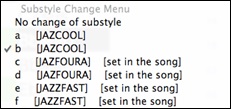
Section Paragraphs
When you are reading a book, a new section begins on a new line, with space between. Band-in-a-Box does that for chords too. Whenever a new section occurs (a part marker), we start the new section on a new line and draw a grey line above to clearly mark the new section. A section can be as short as 2 bars. You will see each section on a new line so that the form of the song is easier to see. The feature is configurable and optional.
Song Form Maker
The Song Form Maker allows you to define sections of a song (A, B, C etc.), and then rearrange the song by simply typing the form you want (e.g. AABABAACA). You can revisit the dialog to change the form at any time.
|
Press the [Song Form] button and select Song Form Dialog from the menu. You will then see the Song Form Maker dialog. Then define your sections (e.g. A = bars 1 for 8 bars, B=start at bar 17, for 8 bars C=start at bar 25, for 4 bars). Then type the form that you want (AABACABA). |
|
Select [OK-Generate Form] then exit the dialog. The form string and sections are saved with the song. |
Chord Sheet Editing Features
The Chord Sheet has a contextual menu that opens with control+click or a right-click in the Chord Sheet area. This menu is a very convenient way to access the features for editing song arrangements.
|
Chords can be copied, pasted, cut, or erased and new chords can be entered from the Chord Builder Chord Settings allow pushes, rests, and pedal bass to be applied. Bar Settings let you refine your arrangement with changes in tempo, meter, key signature, styles, RealDrums, volume levels, patches, and harmonies. Song Settings allow rests and pushes, and control tags, endings, and fadeouts. Display Options allow full customization of the Chord Sheet. Global system settings are accessed in the Preferences. You can also right-click on a bar in the Chord Sheet to set it as the beginning or end of the chorus or the end of the song from the settings in the context menu. For example, these settings are available with a right-click on bar 16. |
This menu can be used to start playback from the highlighted bar in any chorus of the song.
Print Chords will print the Chord Sheet.
Bar-Based Section Letters lets you add a section letter, which will display just above the bar number on the Chord Sheet.
Insert Bars or Delete Bars lets you insert or delete a specific number of bars at the current bar.
Play Song from Chord Sheet
Songs can be played from any location in the Chord Sheet with a double-click on any bar. Playback will start at the bar where the mouse is clicked.
If a tag or an ending is defined, double-click on the ending bar (or a bar in the tag), and the song will play from the ending (or tag). This only applies to the Chord Sheet, since notation windows always play from the ending or tag already.
Play Selected Area as a Loop
To use this function, select a region on the Chord Sheet. To select a region, click a bar and drag the mouse. To select a large region, click a bar and SHIFT-click on the end point.
![]()
|
Then, click on the [Loop] button, and select Play and loop highlighted region from the menu. Alternatively, you can press the [F10] key. |

Unconditional 30-Day Money Back Guarantee on all PG Music products purchased from PG Music Inc.
PG Music Inc.
29 Cadillac Ave Victoria BC Canada V8Z 1T3
Sales: 800-268-6272, 250-475-2874,+ 800-4746-8742*
* Outside USA & Canada where International Freephone service is available.
Access Codes
Tech Support: Live Chat, support@pgmusic.com
 Online now
Online now
Need Help?
Customer Sales & Support
|
Phones (Pacific Time) 1-800-268-6272 1-250-475-2874 |
||
| Live Chat | ||
| OPEN | Online Ordering 24/7 |
|
| OPEN | Forums, email, web support |

